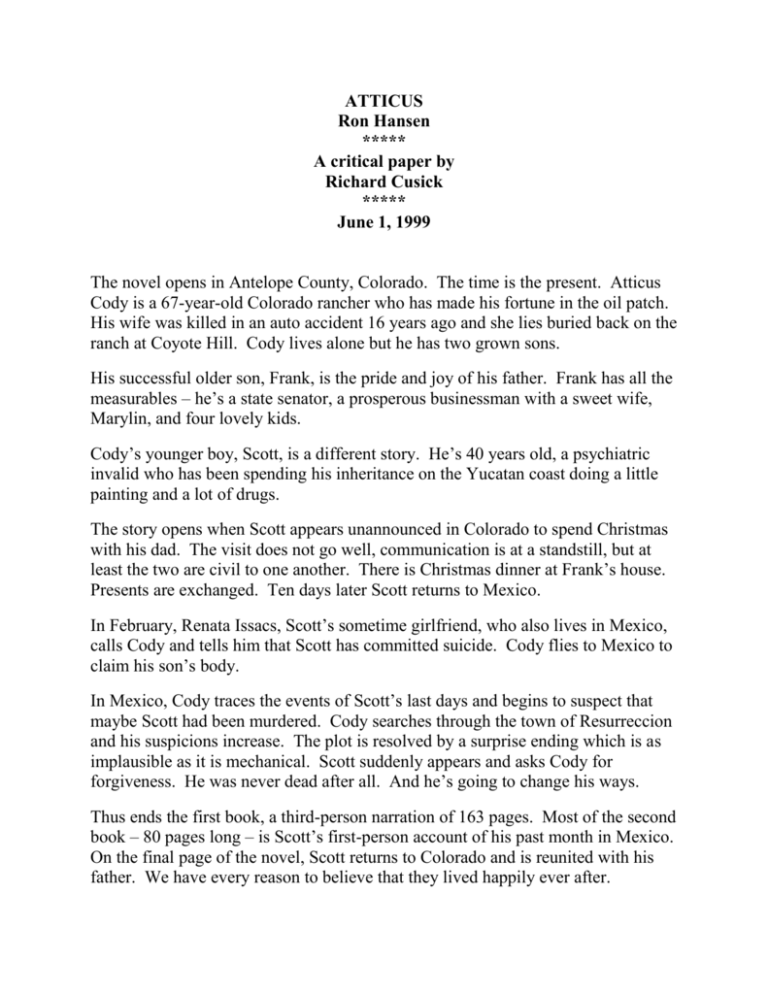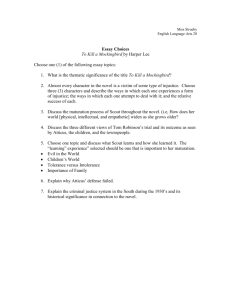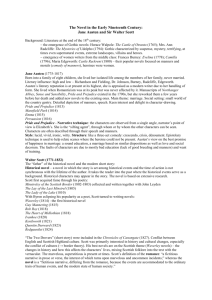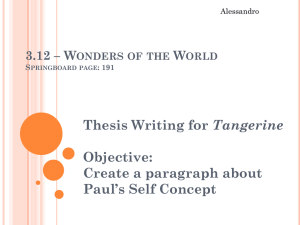ATTICUS
advertisement

ATTICUS Ron Hansen ***** A critical paper by Richard Cusick ***** June 1, 1999 The novel opens in Antelope County, Colorado. The time is the present. Atticus Cody is a 67-year-old Colorado rancher who has made his fortune in the oil patch. His wife was killed in an auto accident 16 years ago and she lies buried back on the ranch at Coyote Hill. Cody lives alone but he has two grown sons. His successful older son, Frank, is the pride and joy of his father. Frank has all the measurables – he’s a state senator, a prosperous businessman with a sweet wife, Marylin, and four lovely kids. Cody’s younger boy, Scott, is a different story. He’s 40 years old, a psychiatric invalid who has been spending his inheritance on the Yucatan coast doing a little painting and a lot of drugs. The story opens when Scott appears unannounced in Colorado to spend Christmas with his dad. The visit does not go well, communication is at a standstill, but at least the two are civil to one another. There is Christmas dinner at Frank’s house. Presents are exchanged. Ten days later Scott returns to Mexico. In February, Renata Issacs, Scott’s sometime girlfriend, who also lives in Mexico, calls Cody and tells him that Scott has committed suicide. Cody flies to Mexico to claim his son’s body. In Mexico, Cody traces the events of Scott’s last days and begins to suspect that maybe Scott had been murdered. Cody searches through the town of Resurreccion and his suspicions increase. The plot is resolved by a surprise ending which is as implausible as it is mechanical. Scott suddenly appears and asks Cody for forgiveness. He was never dead after all. And he’s going to change his ways. Thus ends the first book, a third-person narration of 163 pages. Most of the second book – 80 pages long – is Scott’s first-person account of his past month in Mexico. On the final page of the novel, Scott returns to Colorado and is reunited with his father. We have every reason to believe that they lived happily ever after. Ron Hansen is a skilled writer and Atticus has been widely acclaimed. The Amazon website lists 43 reviews of the novel and almost all of them are complimentary. Nonetheless, I have some reservations about the book and about a trend in contemporary fiction which it exemplifies. To me, Atticus reads like the first draft of a screenplay, as do many other recent novels. There are reasons for this similarity. Fiction writing has long been one of the lowest paid working trades. Nowadays as internet sites and superstores discount book prices, publishing margins are slashed and royalties are reduced. But if a novel can be turned into a movie or TV production, the author’s income can rise dramatically, sometimes by a factor of 10. So there is a tendency on the part of authors to direct their books, not just to the immediate reader who bought the book, but to the film executive who might buy the film rights. There is also the audience to consider. The average reader spends more time watching movies and television than he does reading novels and is more accustomed to the peculiar mechanics and techniques of the media. The more the author can create what has been called a “printed film”, the more comfortable the reader may feel with the book in his hand. There are certain devices and techniques which have come to dominate TV and movie productions. These techniques, it is true, have appeared in literature from time immemorial but never to the extent that they abound in the media. So we are confronting an issue of degree and emphasis rather than an issue of kind. First and foremost is the persistence of clichés in media productions. The cliché is a literary device grounded in imitation and repetition. We commonly think of it as a word or a phrase. But a cliché can also be a setting, a character, a plot, a theme, an ending or a whole story. Authors have long used clichés to attract audiences who find reading difficult or not worth the effort. Juvenile serial novels – The Hardy Boys and The Nancy Drew Mysteries, for example – were easy for children to understand and helped launch many youngsters into lifetime habits of reading. Detective stories, romance novels and the current fad, lawyer novels, have predictable characters and plots which amuse and divert readers unable or unwilling to expend excessive mental energy. The problem with clichés is that they oversimplify reality and quickly become hackneyed and trite. The story loses its freshness and originality and the discriminating reader loses interest. One reason clichés are used in the media is because movies and TV productions are capital intensive ventures. Producers find it easier to attract fresh money if they can show that the proposed production closely resembles a profitable prior 2 iteration. So movies and television have elevated the cliché to a new level. Market researchers seek out formats that attract viewers and the industry sticks with them. TV sitcoms are clichés from start to finish with predictable characters, settings and plots. Turn on Cheers or Seinfeld any night and you know in advance what you are going to see. You can almost tell when to laugh just by looking at your wristwatch. Movies, too, have always thrived on clichés. Westerns and cops and robber films have been staples since the industry was born. When a movie is a box office hit, a sequel is often made. Son of Star Wars is now playing at your local theatre. The stereotyping and redundancy turn off only a minority of potential ticket buyers. The majority of audiences prefer to watch a story they are comfortable with over and over again. Atticus shows us how media-based clichés have come to infect modern fiction. Let me give you specific examples of some of the media-type clichés which appear in this novel. 1. Spectacular Settings. The camera excels in portraying exotic landscapes and directors insist on settings which are visually exciting. This novel has two of the best – the high country of Colorado and the tropical seashore of Yucatan. Both locations should film very well. The author turns to lush phrases to describe the scenes the camera will pan – the palm trees, the white sand, the azure sea, the colorful fiesta, and the college girls in bikinis. The girls are a must these days since industry figures reveal that Baywatch has been shown world-wide more times to larger audiences than any other production. 2. Glamorous Main Characters. Samuel Goldwyn is credited with creating Hollywood’s star system. He reasoned that if he took a beautiful actress and wildly ballyhooed her, her mere presence in a film would ensure its success even if the rest of the production fell apart. Some modern fiction writers have picked up on this practice. They create stars in the movie sense rather than characters in the literary sense. Atticus Cody is meant to be Gregory Peck in his role as Atticus Finch in To Kill A Mocking Bird, a very successful film. Cody is portrayed as strong, saintly and kind to dumb animals – an aging Marlboro Man. Scott is good looking, sensitive, artistic and athletic. Despite his mental infirmities he pumps iron, runs four miles a day and is a strong swimmer. Scott comes across as a Tom Hanks look-a-like. Renata, though getting on in years, is still drop dead gorgeous. She’s described as a “lovely woman”, a “sultry number”, and a “siren”. You can pencil in Sharon Stone’s name for her role. 3 By and large film viewers are not interested in psychological insight or the ramifications of personality theory. And they definitely don’t want stories about ordinary people with ordinary lives. They are looking for characters they can love, and the more glamorous the character, the more lovable they are. Garry Wills observed that the stock roles movie stars portray are regarded by viewers as “conduits used to communicate with their own desired selves or their own desired pasts.” 3. Stock Supporting Characters. Movies and TV focus on the stars and supporting characters are often treated more as props than persons. This novel contains stereotyped supporting characters who have little individuality and only walk-on roles: Frank, the uptight older brother; Stuart Chandler, the stuffy British snob; Hector, the crippled beggar, always at hand for a delicate assignment; the happy-go-lucky Myan children just thrilled to pull your car out of a ditch. 4. Mandatory Happy Endings. Movies and TV are in the entertainment business and the hard-fast rule is that audiences should be feeling good at the end of the performance. So happy endings are the norm. If necessary, logic and reason must bow to fantasy and make-believe. A tragic ending invariably means a box office flop. Mr. Hansen has supplied the requisite happy ending by massive character changes on the part of both Cody and Scott. Their antagonisms, which were rooted in habits and responses ingrained over the years, simply vanish in unexplained changes of heart. 5. Homage to Non-Western Culture. The counter-culture segment in this country must be larger than I think it is or else its members are avid media fans. Movies and TV play to this audience sector and any author looking for a media deal has to add a heavy dose of anti-intellectualism to his book. In Atticus we have Eduardo, the noble shaman, whose ancient wisdom (expressed in the usual incoherence which passes as profundity) diverts Scott’s avenger from his deadly pursuit. The current wave of multiculturalism dictates that novels and movies contain these tedious episodes and all we novel readers can do is endure them. 6. Clumsy Symbolism. Symbolism has always been used by authors but usually sparingly and with a light touch. After all, words themselves are symbols – arbitrary noises used to express ideas. And, as Henry James put it, all human discourse is metaphor. But movies thrive on heavy-handed symbols because they help advance the story in a non-verbal way. In some of today’s film dramas 95% of the scene’s meaning is conveyed before a word is uttered; 98% if you add music. So we are accustomed to see the sheriff in a white hat and the cattle rustlers wearing black. The media’s use of symbolism is so pervasive that when some 4 readers turn off the TV set and pick up a book they expect the same type of symbolism in their fiction. Some book reviewers all but squeal with delight when they find a symbol in a novel, like a diner when he finds a pearl in his oyster. A literary symbol, in theory, is composed of two parts. The vehicle is the thing named and the tenor is the abstract quality associated with it. The first part, the vehicle, should be readily identifiable by the reader, like Manville’s white whale or Coleridge’s albatross. The tenor can suggest various abstractions some of which may be antagonistic to one another. The author departs from this practice by using obscure and ambiguous vehicles. The first one he uses is the sun dog. I’ve never seen a sun dog. For that matter neither had Cody. So the author has to interrupt the narrative to explain it. Now we know what he’s talking about. It’s that double image of the sun the thirsty traveler in the desert movie sees just before he starts seeing the mirages. The phenomenon always films very well. The title character’s name is also used symbolically. But for the past two thousand years the name Atticus has referred to Titus Pomponius, the companion of Cicero, whose work Letters to Atticus is still studied by high school Latin students. So at two places in the novel Mr. Hansen has to point out that he’s referring to the Atticus Finch of the Harper Lee novel lest the reader be confused. 7. Rickety Plotting. Some directors, particularly of action films, have found that incoherence can be a substitute for dramatic intensity. The viewer is not fully made aware of all that is going on and his confusion keeps him riveted to the screen trying to figure things out. Mr. Hansen adopts this technique in his novel. How did Renaldo learn that Scott had caused Carmen’s death? He wasn’t present at the accident scene and there were no other witnesses. Why was Renaldo later shot in the Bella Vista bar? Was it murder or suicide? We don’t know. We are never told. The plot is allowed to open and close in a cloud of speculation. Another puzzle is Scott’s seemingly miraculous cure of his mental illnesses. We are told early in the book that he suffers from chronic manic depression and paranoid schizophrenia compounded by substance abuse involving alcohol, cocaine, marijuana, Dexedrine, Percodan, Ritalin and Valium. With this medical profile an actuary might compute Scott’s life expectancy in months, if not in weeks. Yet at the end of the novel Scott enters prison, writes a coherent account of his activities and shows up in Colorado a few months later apparently cured. 5 8. Distorted Ethical Values. The author had cast his novel in terms of another symbol, the parable of the prodigal son, which once again he feels compelled to explain to us. A parable is a short tale that carries a moral or spiritual message. Because of its simplicity and brevity the device doesn’t stand up well to rigorous or prolonged analysis. Writers are wary of employing a parable in a longer work because the message can become confused and portentous. That seems to have happened in Atticus. In the prodigal son parable the father is victimized by his ungrateful child. But does this novel fit that parable? Scott is a very sick man; twice he’s been committed to the lock-up ward of Hirsch Clinic. His girlfriend, Renata, whom he met at Hirsch, is hardly in better mental shape. They are both drifting through Mexico without medical care or supervision. Cody makes no effort to help or even keep track of them. Instead he squanders his tenderness and concern on his horses and his cat. The novel asks us to sympathize with Cody who unnecessarily grieves for a week thinking his son is dead. But Scott may have been justified in the ruse he arranged. A killer was stalking him and, should he escape that peril, he still faced a session with the corrupt Mexican judiciary and its brutal prison system. When Scott came home for Christmas, Cody constantly criticized him, calling him a juvenile delinquent, comparing him to his successful brother and showing him the wrecked Thunderbird Scott had been driving when his mother was killed. For l6 years Cody has kept that wreck in the barn, with his wife’s hair still stuck on the broken windshield, lest the passing of the years diminish Scott’s guilt and shame. Read this way it is hard to square the storyline with the commonly-accepted meaning of the prodigal son parable. This being said, why did Atticus receive so many favorable reviews? One reason is that, with all its flaws, it is better than many other novels published in 1996. The other reason is that it’s not fashionable to critically analyze fiction these days. The process smacks too much of standards and conformity. Book critics are a dying breed. Book reviewers have taken over. The question book reviewers address is will the book sell? Will the buyer keep turning the pages? Will he finish the damn thing? If the novel pleases, that is all that matters. And Atticus did well. The website states the movie is now in production. By today’s standards the work is a success. But when I finished it and put it down, I felt I could find the same characters in a movie magazine, the same setting in a travel brochure and the same plot in a comic book. 6








